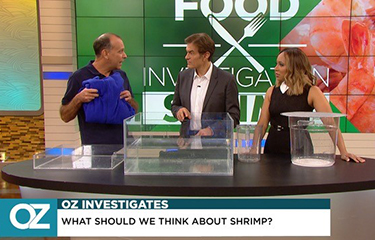The National Fisheries Institute is sharply criticizing an episode of the Dr. Oz Show linking shrimp and antibiotics, slave labor, and microplastics.
In the episode, which aired on 11 November, show host Mehmet Oz interviews Paul Greenberg, author of “American Catch” and “Four Fish: The Future of the Last Wild Food,” about the safety and healthfulness of eating shrimp.
“Because [farmed shrimp] is coming from overseas … in some cases, it is coming from countries with poor governmental oversight,” Dr. Oz Investigative Correspondent Mara Schiavocampo said. “When you have poor governmental regulation, that leads to things like diseased shrimp, overcrowded habitats in what has been described as looking like swamps, overuse of antibiotics, slave labor in raising these shrimp …”
The episode featured wild shrimp fisherman Lance Nacio, owner of Anna Marie Shrimp in Louisiana.
“Domestic shrimp from the Gulf [of Mexico] has been hailed as the best option by experts,” Dr. Oz said.
"Unfortunately, Mara Schiavocampo’s reporting is cut from the same hyperbolic cloth we always see adorning the content from this show," Gavin Gibbons, vice president of communications at NFI, told SeafoodSource. "Her unspecified and cavalier mentions of things like slave labor associated with shrimp are glib and poorly researched. It’s clear she has no idea the lengths the shrimp industry itself has gone to ensure a full value chain that is free from labor abuses"
Another concern raised on the show was microplastics in seafood.
“Plastics are a huge problem in all of our seafood. Right now, we have about five to 10 million metric tons of plastics going into our oceans every single year,” Greenberg said on the show.
“So, the shrimp eat that plastic?” Dr. Oz asked.
“It's getting into all of our seafood. When they did a recent survey of all the seafood that was coming out of the San Francisco area for example, they found that about a third of all seafood had plastic in their guts. Yeah, shrimp is going to be part of that,” Greenberg replied.
Gavin Gibbons, vice president of communications for NFI, criticized the show for presenting misleading information.
“We strongly recommend that consumers get their seafood nutrition information from anywhere, but the Dr. Oz show. Dr. Oz has a terrible track record with regard to reporting on seafood and on other issues has even been called to task for his sloppy work by Congress," Gibbons told SeafoodSource.
Studies, such as one from the journal “Environmental Science & Technology," find that humans actually get few microplastics in their systems from eating seafood, Gibbons said.
“In fact, they ingest far more from simply breathing and no credible doctor on the planet would suggest people breathe less. Also, keep in mind the micro plastic dialog comes during a discussion about plastic in the ocean, yet no one ever notes that the vast, vast majority of the shrimp Americans eat does not come from the ocean at all but is, in fact, farmed,” he said.
Greenberg also compared the value of buying shrimp that was frozen in a block versus individually quick frozen (IQF) shrimp. In block form, consumers are paying for the ice, he claimed.
“Greenberg’s comments on block frozen shrimp are nothing short of nonsense,” Gibbons said. “His insistence that consumers are paying for the ice is wrong. That is illegal and is called fraud. Consumers pay for the net weight of the product itself, not the ice. Period.”
IQF shrimp, on the other hand, have a “much better texture, much better taste,” Greenberg said. “If you want to go a step further than IQF … look for these certifications, because this ASC, the BAP, the GAA, sorry a lot of alphabet soup here, but that means they weren't treated with the antibiotics and we really want to avoid that.”
“It is positive that the show provided accurate information about third-party shrimp certifications like BAP. That’s at least a start,” Gibbons said.
“We encourage consumers to look for the blue Best Aquaculture Practices label when purchasing seafood,” Steve Hedlund, communications manager for Global Aquaculture Alliance (GAA), which operates the Best Aquaculture Practices (BAP) program. The BAP certification program offers aquaculture standards encompassing environmental responsibility, social responsibility, food safety, and animal health and welfare.
“BAP encompasses the entire aquaculture production chain — processing plants, farms, hatcheries and feed mills,” Hedlund added. “Choosing BAP seafood means you’re choosing seafood that is safe, sustainable, and ethically sourced.”
Photo courtesy of Sony Pictures Television







